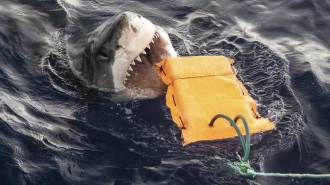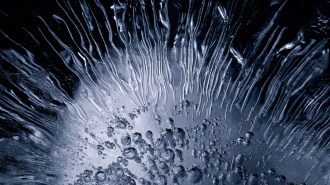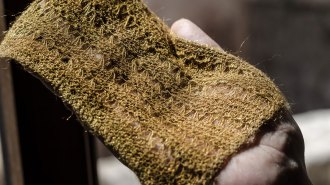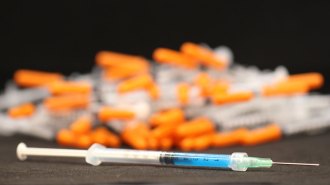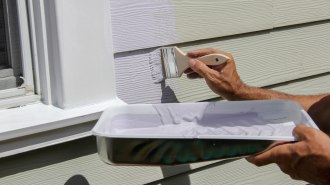Mammal cells make fake spider silk better
The tough silk spun by spiders with the greatest of ease has long inspired human imitators. In a process not yet fully understood, spiders transform dissolved proteins in their silk-making glands directly into thin, rugged filaments of various types. The most tenacious of those strands is dragline silk, which forms the resilient framework of webs. Gram for gram, dragline fiber is five times as strong as steel.


Now, a team of industrial and military scientists claims to have made artificial dragline silk that is nearly as good as the real thing. What’s more, the team’s water-based fabrication method yields artificial silk in greater quantities than ever before and avoids the environmentally unfriendly chemicals common in artificial fiber production, say the silk’s developers at Nexia Biotechnologies in Vaudreuil-Dorion, Quebec, and the U.S. Army Soldier Biological Chemical Command (SBCCOM) in Natick, Mass.
“This is way in advance of anything so far,” comments David P. Knight, a spider silk researcher of the University of Oxford in England.
Similar to nylon and Kevlar, genuine spider dragline silk is not only stronger than these synthetics, but it’s also at least three times as tough–which refers to how much energy it absorbs before breaking. Given those superior qualities, says Nexia’s president, Jeffrey D. Turner, manufacturers would love to mass-produce the filaments for use in such items as ropes, seat belts, and bullet-proof vests (SN: 3/9/96, p. 152: http://www.sciencenews.org/sn_edpik/ps_5.htm).
However, spiders won’t stand for being herded together to create silk farms. Seeking mass-production alternatives, researchers have tried dissolving webs and then respinning thread from the solutions. They’ve also cloned silk-protein genes (SN: 2/21/98, p. 119: http://www.sciencenews.org/sn_arc98/2_21_98/fob2.htm) and inserted them into bacteria and yeast cells. No approach has yet produced silk quite like the real thing.
Nexia’s researchers have added a twist to the cloning tack. Instead of inserting silk genes into microbial cells, they used cells removed from cows and hamsters. In the Jan. 18 Science, they describe what happened when they put a silk-protein gene from the common garden spider Araneus diadematus into hamster cells.
They report that the cells yielded unprecedented amounts of the silk protein called ADF-3. Bacteria and yeast don’t naturally make the types of proteins in silk, which include repetitious sequences of their amino acid building blocks, notes Nexia’s Costas N. Karatzas. Nor do these microorganisms usually secrete proteins, he adds. However, the mammal cells naturally do both, a trait that Karatzas says may help explain the new experiments’ success.
Once the hamster cells secreted ADF-3 into surrounding fluid, the researchers purified the protein and made a more concentrated solution. Next, they spun the viscous fluid into fibers by pushing it through small tubes and then stretching the resulting materials in a methanol-water mixture or pure water.
The result: silk as tough as bona fide dragline silk, albeit considerably weaker and twice as stretchy. “We’re producing fibers with properties similar to those of the spider. Nobody has been able to do that previously,” says Steven Arcidiacono of SBCCOM.
“It isn’t a perfect mimic,” admits Turner, who calls the new material a biodegradable nylon. Even so, its mechanical quality may already be suitable for sutures and fishing line that self-destructs if left behind in the water, he says. Also, prospects are bright for improving the fibers’ strength. The scientists plan to add other proteins to the mix, as spiders presumably do, and modify how the fibers are spun.

